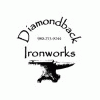kindrage,
Every forge in the Diamondback Ironworks line-up will reach welding heat, so no matter if it's a single, double or triple burner, they will all get hotter than you'll ever need (heat is controlled by gas pressure). I say that because many think that the more burners you have, the hotter the forge will get, but fact is, our single burners get as hot as out 3 burner models.
With that out of the way, the major consideration is the type of work you are doing and what you plan to do in the future. The Knifemaker models (1 and 2 burners) are just what they say, they are designed for Bladesmithing. They have small openings in each end to allow your stock to pass through, but with no front door they are very limited in what you can get inside. If all you're doing is blades, these are they way to go. The Blacksmith models (2 and 3 burners) offer a larger firebox, openings in each end for barstock to pass through and a large front door which allows greater access to the firebox. These forges are ideal for general blacksmithing and in fact, the 2 Burner Blacksmith is the forge I personally use for my ironwork, along with a single burner knifemaker for my blades. The Metal Artist model (2 burner) is even more versatile still, without the front corners it allows complete firebox access with the front door open, the drawback is the larger end openings are responsible for more heat loss, so it's gas usage is slightly higher than the Blacksmith models. The Metalsmith models (2 and 3 burners) offer an excellent compromise between access and efficiency. They are essentially a Metal Artist forge with end doors as well as a front door. With all doors closed the forge has stock ports in each end door for barstock to pass through. This allows the forge to maintain higher heats with less fuel use. When you need more access, any of the doors, or even all 3, can be opened, allowing you to get whatever you need into the firebox, wherever you need it.
Again, it comes down to what you plan on doing, but I say for Bladesmithing, the 1 or 2 Burner Knifemaker is a great choice, it just depends on the length of blades you'll be working. For general Blacksmithing, the 2 Burner Blacksmith is an excellent choice. There are many choices out there in many different price ranges, but there isn't a (professionally manufactured, commercial quality) forge made in the US that ours won't run head to head with, so shop carefully. Even at the high end, our 3 Burner Metalsmith can be delivered anywhere in US for well under $700!


